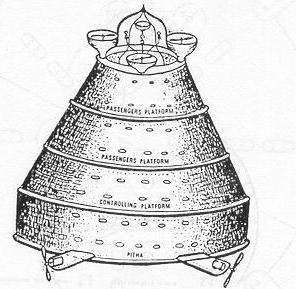Summary: Many ancient documents written in Sanskrit, especially one called “Vimanika“, written by Bharadvajy and found in 1875 inside an old Indian temple, describes how to build “vimanas” (celestial chariot), how to pilot one and so on. In other documents, it is said that certain Gods traveled and ruled everywhere on their vimanas.
Many ancient documents are written in Sanskrit, especially one called “Vimanika“, written by Bharadvajy and found in 1875 inside an old Indian temple, describes how to build “vimanas” (celestial chariot), how to pilot one and so on.
In other documents, it is said that certain Gods traveled and ruled everywhere on their vimanas.
Made of wood or metal, the first ones of wood and covered with a substance that gave them a great resistance, lightness, and strength. When metal was used, it was an alloy of two white and one red metal (probably copper, magnesium and aluminum). A sheet of this alloy was put on the surface of the vimana and soldered electrically. There was no joint. And the vimana was shiny and lightful during the night! About the propulsion system, it seems firstly the “vril” was used: through the personal vibrations, the object could levitate.
Lately, a system of tubes along the vimana’s sides could bring the energy towards the eight terminal tubes on the lower side, or on the eights on the upper side, to produce thrust. Practically, there were sixteen reactors and maybe Kerosene was used as fuel. Another propulsion system was based on mercury: ionic motor?
In one other book called “Dronaparva“, vimanas are described as spheres that emitted a split of fire and moved very fast thanks to a mercury motor. Again: Russians have discovered in some Turkistan‘s caves (Gobi desert) some semispheres made of glass and porcelain containing some drops of mercury!
The Gods were humanoids (aliens) in possess of a scientific culture the rest of the poor people could not have. They ruled different areas from Poseidonia (actually Atlantis), brought culture but declared war to each other. Just fiction? NO! The ruins of Mohenjo-Daro (Lanka, India) show today how 2’500 years before Christ it was a complex city of 400’000 people.
But 1’500 years b.C. the city was suddenly abandoned since a small nuclear bomb was thrown. Inside the city, along a trace of some tens of meters, the bricks have been exposed to strong radiation (900° C for few seconds) and the few skeletons found seem having been thrown towards one point (shockwave?). Doctor Corrado Malanga could analyze chemically two artifacts from Mohenjo-Daro: they showed so very high standards of Uranium, Plutonium and Potassium 40 that today they’d be considered unusable for construction!!
